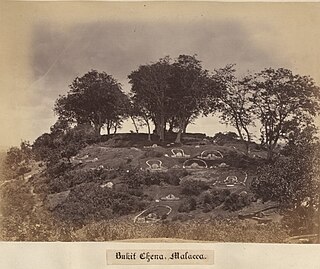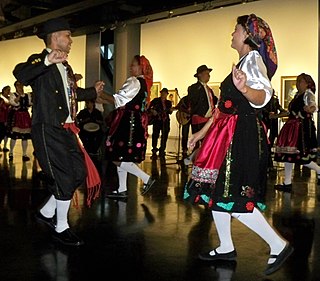
The Straits Settlements were a group of British territories located in Southeast Asia. Originally established in 1826 as part of the territories controlled by the British East India Company, the Straits Settlements came under British Raj control in 1858 and then under direct British control as a Crown colony on 1 April 1867. In 1946, following the end of the Second World War and the Japanese occupation, the colony was dissolved as part of Britain's reorganisation of its Southeast Asian dependencies in the area.

Bukit China is a hillside of historical significance in Malacca City, the capital of the Malaysian state of Malacca. It is located several kilometres to the north from the historical centre of Malacca, but these days, it's surrounded by the modern city on all sides.

Malacca City is the capital city of the Malaysian state of Malacca. As of 2019 it has a population of 579,000. Malacca City is one of the cleanest cities in South East Asia, being awarded as National Winner of Asean Clean Tourist City Standard Award 2018–2020 recently. It is the oldest Malaysian city on the Straits of Malacca, having become a successful entrepôt in the era of the Malacca Sultanate. The present-day city was founded by Parameswara, a Sumatran prince who escaped to the Malay Peninsula when Srivijaya fell to the Majapahit. Following the establishment of the Malacca Sultanate, the city drew the attention of traders from the Middle East, South Asia, and East Asia, as well as the Portuguese, who intended to dominate the trade route in Asia. After Malacca was conquered by Portugal, the city became an area of conflict when the sultanates of Aceh and Johor attempted to take control from the Portuguese.

Tanjungpinang, also written as Tanjung Pinang, is the capital city of the Indonesian province of Riau Islands. It covers a land area of 144.56 km2, mainly on the southern Bintan Island, as well as other smaller islands such as Dompak Island and Penyengat Island. With a population of 227,663 at the 2020 Census, it is the second largest city of the province, after Batam. Tanjungpinang is a historic city of the Malay culture, having served as the capital of both Johor Sultanate and Riau-Lingga Sultanate.

The Kristang or Serani are a creole ethnic group of people of predominantly mixed Portuguese and Malaccan descent, with substantial Dutch, British, Jewish, Malay, Chinese and Indian heritage. They are based in Malaysia and to some extent in Singapore. People of this ethnicity have, besides Portuguese, a strong Dutch heritage due to intermarriages, which is common among the Kristang. In addition, due to persecution by the Portuguese Inquisition in the region, a lot of the Jews of Malacca assimilated into the Kristang community. The creole group arose in Malacca between the 16th and 17th centuries, when the city was a port and base of the Portuguese Empire. Some descendants speak a distinctive Kristang language or Malacca Portuguese, a creole based on Portuguese. Today the government classifies them as Portuguese Eurasians.

A Famosa (Malay: Kota A Famosa; "The Famous" in Portuguese, also known as Fortaleza Velha Portuguese: the old fortress, and Dutch: Slavenburgh & De Misericorde was a Portuguese fortress built in Malacca, Malaysia, in 1512. The oldest part of the fortress was a five-storey keep which gave its name to the fortress as a whole. Some time following the Battle of Malacca and the occupation of the city by the Dutch, the keep was destroyed but the outer walls of the fortress were reinforced. However, in 1807 the British destroyed most of the fortress. The Porta de Santiago gateway, and the restored Middelburg Bastion, are the only parts of the fortress that remain today. They are among the oldest European architectural remains in Southeast Asia and the Far East.

Malay was first used in the first millennia known as Old Malay, a part of the Austronesian language family. Over a period of two millennia, Malay has undergone various stages of development that derived from different layers of foreign influences through international trade, religious expansion, colonisation and developments of new socio-political trends. The oldest form of Malay is descended from the Proto-Malayo-Polynesian language spoken by the earliest Austronesian settlers in Southeast Asia. This form would later evolve into Old Malay when Indian cultures and religions began penetrating the region, most probably using the Kawi and Rencong scripts, some linguistic researchers say. Old Malay contained some terms that exist today, but are unintelligible to modern speakers, while the modern language is already largely recognisable in written Classical Malay of 1303 CE.

The Sultanate of Aceh, officially the Kingdom of Aceh Darussalam, was a sultanate centered in the modern-day Indonesian province of Aceh. It was a major regional power in the 16th and 17th centuries, before experiencing a long period of decline. Its capital was Kutaraja, the present-day Banda Aceh.

Dutch Malacca (1641–1825) was the longest period that Malacca was under foreign control. The Dutch ruled for almost 183 years with intermittent British occupation during the Napoleonic Wars (1795–1815). This era saw relative peace with little serious interruption from the Malay sultanates due to the understanding forged between the Dutch and the Sultanate of Johor in 1606. This time also marked the decline of the importance of Malacca. The Dutch preferred Batavia as their economic and administrative centre in the region and their hold in Malacca was to prevent the loss of the city to other European powers and, subsequently, the competition that would come with it. Thus, in the 17th century, with Malacca ceased to be an important port, the Johor Sultanate became the dominant local power in the region due to the opening of its ports and the alliance with the Dutch.

Portuguese control of Malacca, a city on the Malay Peninsula, refers to the 130 year period (1511–1641) when it was a possession of the Portuguese East Indies. It was conquered from the Malacca Sultanate as part of Portuguese attempts to gain control of trade in the region. Although multiple attempts to conquer it were repulsed, the city was eventually lost to an alliance of Dutch and regional forces, thus entering a period of Dutch rule.

The Royal Malaysia Police trace their existence to the Malacca Sultanate in the 1400s and developed through administration by the Portuguese, the Dutch, modernization by the British beginning in the early 1800s, and the era of Malaysian independence.
Piracy in Indonesia is not only notorious, but according to a survey conducted by the International Maritime Bureau, it was also the country sporting the highest rate of pirate attacks back in 2004, where it subsequently dropped to second place of the world's worst country of pirate attacks in 2008, finishing just behind Nigeria. However, Indonesia is still deemed the country with the world's most dangerous water due to its high piracy rate. With more than half of the world's piracy crimes surrounding the South-East Asia aquatic regions, the turmoil caused by piracy has made the Strait of Malacca a distinct pirate hotspot accounting for most of the attacks in Indonesia, making the ships that sail in this region risky ever since the Europeans arrived. The term 'Piracy in Indonesia' includes both cases of Indonesian pirates hijacking other cargo and tanks, as well as the high rate of practising piracy within the country itself. The Strait of Malacca is also one of the world's busiest shipping routes as it accounts for more than twenty-five percent of the world's barter goods that come mainly from China and Japan. Approximately 50,000 vessels worth of the world's trade employ the strait annually, including oil from the Persian Gulf and manufactured goods to the Middle East and Suez Canal. The success that stems from this trade portal makes the Strait an ideal location for pirate attacks.

Christ Church, Malacca is an 18th-century Anglican church in the city of Malacca City, Malaysia. It is the oldest functioning Protestant church in Malaysia and is within the jurisdiction of the Lower Central Archdeaconry of the Anglican Diocese of West Malaysia.

Saint Paul's Church is a historic church building in Malacca City, Malaysia that was originally built in 1521, making it the oldest church building in Malaysia and Southeast Asia. It is located at the summit of St. Paul's Hill and is today part of the Malacca Museum Complex comprising the A Famosa ruins, the Stadthuys and other historical buildings.

Malacca is a state in Malaysia located in the southern region of the Malay Peninsula, next to the Strait of Malacca. Its capital is Malacca City, dubbed the Historic City, which has been listed as a UNESCO World Heritage Site since 7 July 2008.

The Malaysia Architecture Museum is an architecture museum in Malacca City, Malacca, Malaysia which exhibits various architectural materials, building models and concepts.

St. Paul's Hill is a hill in Malacca City, Malacca, Malaysia. It was originally known as the Malacca Hill during the Malacca Sultanate period and Mary's Hill during the Portuguese Malacca period.

The Poh San Teng Temple (Chinese: 宝山亭; pinyin: Bǎo Shān Tíng is a Chinese temple located at the foot of Bukit China, next to the Malacca Warrior Monument and King's well in Malacca City, Malacca, Malaysia. The temple is dedicated to Tua Pek Kong and was founded in 1795 during the era of Dutch Malacca by Chinese Kapitan Chua Su Cheong.
The Naning War, also known as the Naning conflict or the Naning revolt, occurred between 1831 and 1832 in the territories surrounding the city of Malacca, Malaysia. The conflict was fought between the British East India Company (EIC), which had taken over Malacca and its surrounding lands from the Dutch in 1824, and the Malay chiefdom of Naning which bordered Malacca. Issues that led to the Naning War include the growing British interests in the Malay Peninsula, as well as a different understanding of the extent of British jurisdiction over and right to impose taxation on Naning. The British defeated Naning following two military expeditions and fully incorporated the territory under Malacca's jurisdiction.

















